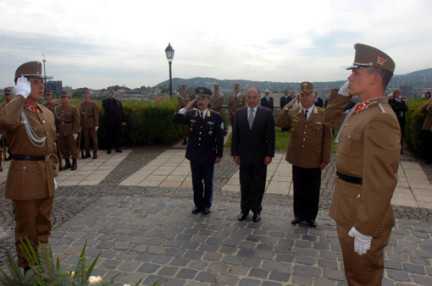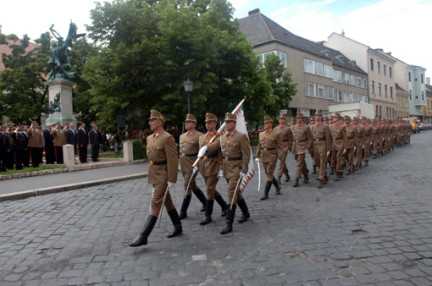Day of National Defence in the Castle: Wreath Laying and Hoisting of the Colours
Szöveg: László Szűcs | 2008. május 26. 6:49”After the name of God, the word ’honvéd’ [a soldier in charge of national defence] is the second most beautiful and holiest name” – wrote the poet Sándor Petõfi in one of his poems. And the participants of the celebration held in the Buda Castle on 21st May, the day of Hungarian National Defence, had the same thought on their minds.
There were hundreds of interested people waiting for the celebration to commence at the Honvéd Memorial in Dísz Square, in the Buda Castle district. As the narrator said "… today we remember the heroes who lined up as soldiers under the tricolour of the nation on 21st May 1849, and faced death bravely, singing the national anthem while attacking the strongholds of the enemy."
"First and foremost, this day is the day of remembrance, a celebration in honour of the predecessors who had defended their homeland heroically. Nevertheless, it also has to be mentioned today that Hungarian soldiers – just like in the past – deserve all our respect in these times, as well. Be it a contracted soldier, a professional serviceman, regardless of the location they are serving at, both within the boundaries of the country, and in an international mission" – sounded the message on the loudspeaker.
The participants of the event following the introduction included Minister of Defence Dr. Imre Szekeres, General András Havril, Chief of the Defence Staff, Mr József Bali, State Secretary for Defence Policy, Lieutenant General (Eng.) János Mikita, Deputy Chief of Defence Staff, Lieutenant General (Eng.) László Tömböl, Commander of HDF Joint Forces Command, furthermore HDF generals, and several military attaches accredited to Hungary.
The representatives of the Ministry, the Chief of the Defence Staff, military and civil organizations, and that of the unions have laid wreaths and flowers of remembrance on the Honvéd memorial in Dísz Square, in front of the row of mounted Hussars and ’traditionalists’ dressed in uniforms of the period of the fight for freedom.

Following the procession and Il Silentio, the attendees of the celebration went up to the Fehérvár Barbican, where they have laid wreaths on the statue of Honvéd General Artúr Görgey. At the memorial we have learned that the successful occupation of the Buda Castle – the General was not more than 31 years old at the time – was the ’crown’ of the glorious Spring Campaign, and the General had proven his excellent capabilities, when he forged the poorly equipped Hungarian forces into an army within a short time.
The celebration continued at the Esztergom Barbican, where the flag of the Republic of Hungary was hoisted, accompanied by the tune of the national anthem, and the sound of a 1848 cannon salute. Later Minister of Defence Dr. Imre Szekeres welcomed the participants of the event in the Marble Room of the Institute and Museum of Military History (HIM).
The Minister has recalled the memoirs of one of the 1848-49 Honvéd generals, József Nagysándor, who reported on the event when on 21st May 1849 a 31-year-old Private named Grácián Püspöki – who had served as a banner-bearer with the 47th Honvéd Battalion – was the first man to get up to the Castle. It happened nearby today’s Fehérvár Barbican. There was another man around, who had watched over every move the young banner-bearer made. Artúr Görgey, who was also 31 years old that year, was monitoring the private through the smoke of the siege with a pair of binoculars. As soon as the young man reached the Castle, he unfolded the flag without any delay. Görgey, who wasn’t a talkative man, cried out with anxiety.

According to the writer of the memoirs – said the Minister of Defence – this was one of the most graceful and holiest moments of the siege, for the life of the private, aged 31, and that of the general, of the same age, had intertwined in a second. Dr. Imre Szekeres has also told that owing to similar memoirs, today we know the name of numerous Hungarian soldiers who had participated in the siege of the Buda Castle. Before 1848, the situation was different. The Defence Minister has added that during the days between the 4th and the 21st of May, a thousand Hungarian soldiers had fallen. The soldiers of the Hungarian Army established by Prime Minister Batthyányi, filled up with enthusiasm by Kossuth, and made to triumph by Görgey and other generals.
"Their victory was full, though there were some losses as well. Owing to these men Hungary had protected the achievements of civil transformation, even though the country could not preserve its freedom and independence, due to the enemy forces which had outnumbered them" – highlighted Dr. Imre Szekeres, who also added that the Defence Forces of 1848-49 had done their duty. It was not up to them that Világos and Arad had happened.
According to the Defence Minister the Hungarian Defence Forces, which celebrate their 160th anniversary this year, and the Flotilla, aged 160 as well, the 90-year-old Institute and Museum of Military History, and the 70-year-old independent Hungarian Air Force are important milestones in the history of Hungarian military, since the Hungarian Defence Forces of our time build on the traditions, and take care of the future by their presence.
The series of events taking place in the Buda Castle on the occasion of the Day of Hungarian National Defence have ended by the opening of travelling exhibition titled ’160 years of the Hungarian Defence Forces’. The exhibition on display in the Marble Room of HIM was handed over to the audience and to the Commander of HDF Joint Forces Command by General András Havril, Chief of HDF Defence Staff. As General Havril told in his opening speech, in the same room which is now the home for the exhibition, the last fifty dragoons of the Imperial cavalry had laid down their arms 159 years ago, on 21 May 1849.

"This exhibition is a reflection of the outstanding achievements, the successes and failures alike of the Hungarian Defence Forces. I am convinced that the objects on display are very important for every Hungarian soldier, in order that they can fulfil their tasks with honour in the future" – said the Chief of Defence Staff.
Lieutenant General (Eng.) László Tömböl, to whom the exhibition was handed over, emphasized: he would like as many soldiers as possible to visit the exhibit. Each Hungarian troops should make themselves familiar with the relics of won and lost battles, the memorabilia of the hell of the two World Wars, and the moments of peaceful everyday life.